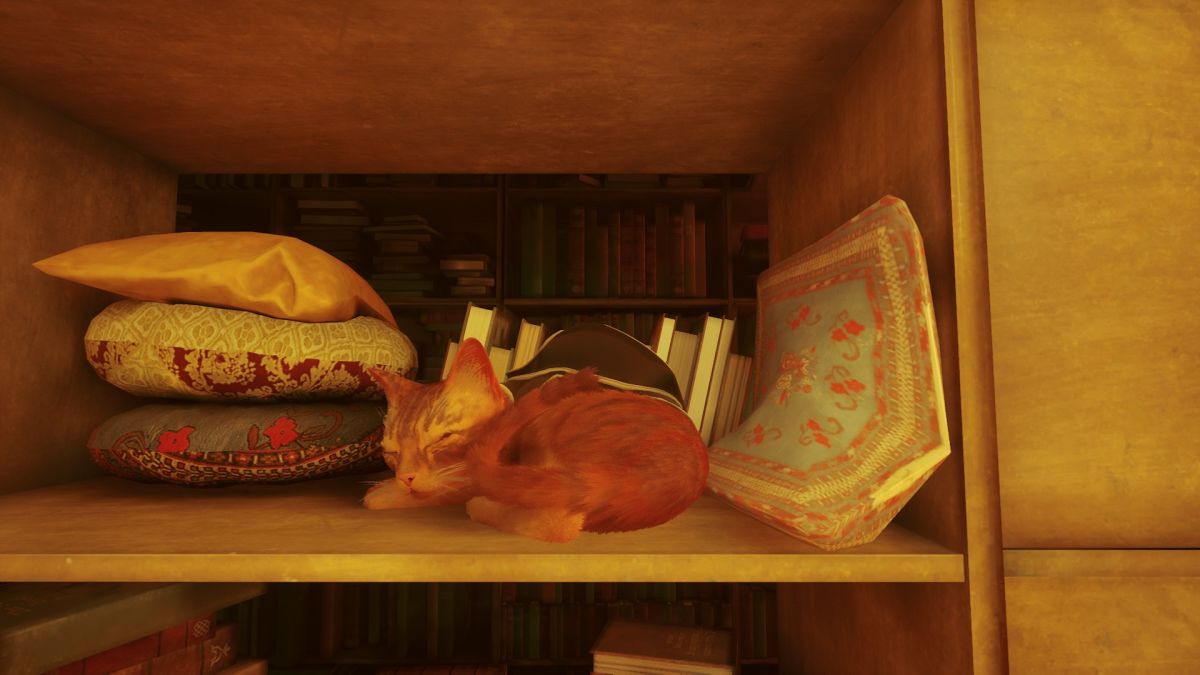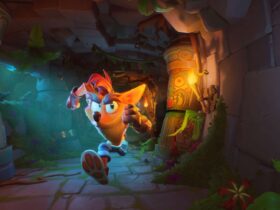Vagrant comments
what is it? A post-apocalyptic puzzle-platformer adventure starring the resourceful Moggie.
Expected payment: £24.99/$29.99
release date: July 19, 2022
Developer: blue twelve studio
Publisher: Annapurna Interactive
Comment on: RTX 2070, i7-10750H, 16GB RAM
multiplayer game? Do not
Association: Official website(opens in a new tab)
The early novelty of playing cats in Stray quickly gave way to a startling realization that we often act like cats in games anyway. Especially in a platformer like this one, our first inclination is to explore, looking for unorthodox routes along the sides of buildings, or jumping on furniture to see what objects we can manipulate. Stray just made these activities more natural, giving us the perfect form of work.
Here, your moggy’s feel is crucial, and it’s immediately apparent how much observational work her animation has put into it. The slender ginger tabby is one of a group of small cats that lives in an abandoned industrial area that has long been reclaimed by nature. As the game begins, your gang waits out the storm in concrete shelters where you can pick up a little fight or sniff and smear each other. These interactions are full of recognizable details – the way the ears flick and rotate, the stretching routine – and if you like cats (like I do), Stray should make you “meow.”
(Image credit: Annapurna Interactive)
The next morning you and your crew venture out with leaves still dripping from last night’s downpour. You might stop for a lap in the pool, or use the trunk as a handy scraping post between jumping steps and spanning gaps. At first, it seems too canonical, you can only jump when a button prompt appears on a nearby ledge, box, or pipe, and a successful landing is guaranteed. However, the system is well-suited to the lightness of well-targeted animals that don’t care about frantic jumps, but rather scan the environment for clearly accessible surfaces. While there are times when Stray abuses its controls and refuses to let you jump on buckets and boxes just because they’re not part of the base path, the overall result is a smooth, satisfying pause, look, jump loop that maintains the feline’s illusion.
nasty zurk
In fact, the wandering and raiding rhythm introduced in the opening minutes could have kept me entertained for a while. As it happens, however, the plot quickly intervenes: a rusty pipe betrays our down-to-earth avatar as she jumps over a chasm, snaps under her weight, makes her fall, and then falls back into in the dark. She’s now trapped in far less idyllic conditions – dusty, rubbish-ridden ruins. Looking up, there is a halo in the distance, and a sad meow echoes from there. From such an innocent start, it’s a gut feeling. I can’t remember the last time I cared so much about the fate of a game’s protagonist.
The next game will be a journey to the top again, revealing the fate and legacy of an extinct human along the way. It seems that people built the underground city you fell into because the surface of the earth had become poisonous just to serve their purpose long before the outside bloomed again. All that’s left are their former robotic servants, uncontrolled by direction, and a horde of pesky beasts called zurks that look like half-hit baby head crabs that exist only to chew on anything that moves.
(Image credit: Annapurna Interactive)
At various stages of your adventure, you’ll have to traverse zurk-infested areas, usually marked by an unsightly layer of goo, as if a giant pizza had exploded. At first, the only way to survive the zurks was to run for your life, dashing into the screen while scribbling a path between squeaky blobs and weaving quickly to avoid their grasp. Later, you’ll find they’re blocking your path and have to lead them astray by tricking them into chasing after you with mocking meows—a reverse game of cat and mouse. None of these are particularly strenuous, however, and while it’s certainly possible to get caught, these parts are mostly used to change the speed between easier jobs.
dream machine
You will also soon find a friend to give you some technical guidance. Jumping along the city’s concrete peaks, under the watchful eye of surveillance cameras, a series of neon signs seem to guide you to a certain place. Follow this path and you’ll meet an AI named B-12 who wants to get back outdoors with you. It uploads itself into a small drone and 3D prints a harness around the cat for its own habitation. The B-12 is now your sidekick, and you need your mouth and hands to talk to robots, knock on doors, and store puzzle-solving items—critical in a concrete-and-metal metropolis where no one thought of installing cat flaps.
Once you’ve found a little oasis in the chaos of a robot home, you’ll be most dependent on your buddies. The place is full of life, though not, with neon signs on the streets deftly twisting the edgy cyberpunk connotations, bringing a healthy glow to the sun-drenched enclave. Now, Stray gives you room to play again, as the B-12 helps you find information from the robots and helps them in return. For example, a barter robot will trade useful gadgets for energy drinks, while a guitarist wants you to find sheet music so she can play some songs.
(Image credit: Annapurna Interactive)
These bots aren’t just mission providers — they’re essential supporting actors. It’s fascinating how artificially built machines draw inspiration from the cultural shards of the makers’ dead. They don human clothes and show facial expressions on monitor heads, crowned by hairs made of wires—a fashion sense that stems from half-understood imitation, but feels great since it’s not socially programmed reality. At the same time, they don’t have a frame of reference when they encounter cats, so when you jump on their table and knock over their cups, they’re just standing lazily. In other words, they’re like every small RPG NPC you’ve ever seen, except here they make sense.
moji style
Likewise, as you begin to criss-cross this densely populated settlement and its interior—jumping over bars next to collapsed drinkers, or between bookshelves in researchers’ labs—the solidity of Stray’s landscape Sex will come to the fore. 3D game worlds are often an awkward mix of non-moving objects and other objects that fly or snap at the slightest touch, but from a cat’s point of view, that’s how things work. Most things are too heavy to break, except for those empty bottles you can spread out, or a pile of books you jump on, and then teeter over when you push yourself away again. Despite the occasional visual anomaly, such as clipping or brief animation glitches, Stray creates a believable logic for the way your fun-sized tiger navigates the space.
Because of this, it becomes especially tempting to indulge your sense of mischief and curiosity about kittens. The wheelie bin and air conditioner provide a quick vertical ascent, and once you’re on the roof, can you resist picking the paint can off the windowsill? Or on the ground, how about entering a home and pulling down the curtains or scratching the carpet? It’s always fun. However, rather than being gratuitous, causing mild confusion seems like a side effect of innate curiosity, traversing a world not built for your intuition. You’re not clumsily destroying this place, you’re expressing yourself, strongly encouraged by game design.
(Image credit: Annapurna Interactive)
For the rest of the time, Stray continued to oscillate between playfulness and danger. As your determined cat gradually resurfaces again, you’ll make new robotic friends, help them achieve their goals, get into closer conflict, and learn more about the buried city’s history in the detailed ruins. The goals are kept clear and simple throughout the 6 to 8 hour runtime, leaving plenty of room for you to enjoy world building and simply be a cat.
cool for cats
In a way, this simplicity is a weakness, as it feels like there’s room for Stray to further expand its systems and your skills, adding urgency to jump sequences, or increasing the complexity of its puzzles. Because it doesn’t, some sequences get stuck in low gear, such as when you’re going to fight back against the zurks, which boils down to back-and-forth repeatedly (and puts the B-12’s prosaic digital abilities center stage, while Not our furry heroes), or haven’t evolved enough to shed their sense of lack of originality, offering missions that follow well-rehearsed genre lines.
(Image credit: Annapurna Interactive)
Still, Stray makes up for this miss by making sure that each idea makes room for the next before it leaves a stain, acting only as part of a whole. But more importantly, it’s still a revelation precisely because it takes familiar adventure game tropes and grunts them with smoother, clearer mechanics. Rather than providing a crude simulation of human-human interaction, it establishes a brief but impactful interdependence between cats and robots. Stray’s commitment to this premise, full of the nuances of feline and robot life, is a triumph.
Playing the cat is always a pleasure throughout the process. Perhaps the biggest endorsement I can give Stray is that even some of the unsuspecting stealth sequences in the final third are not only bearable, but actually entertaining — for the first time, for sure. Like a lot of things in games, characters make them work. So what it lacks in complexity more than makes up for in agility and adaptability. If only more games had such sharp intuitions.
Discover more articles in our categories Gaming & News et Anime.
Thanks for visiting we hope our article Vagrant comments
, don’t forget to share the article on Facebook, instagram and e-mail with the hashtag ☑️ #Vagrant #comments ☑️!














Leave a Review